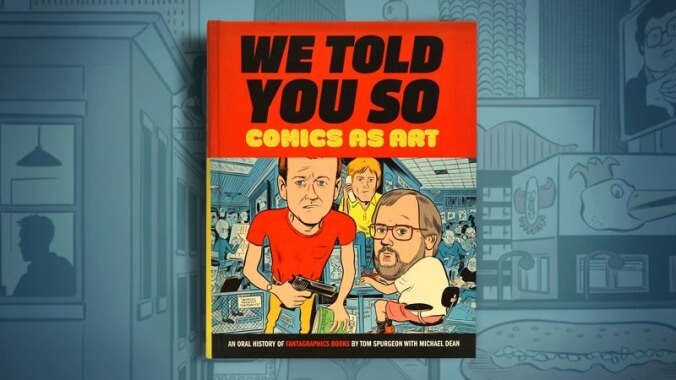The underlying theme in the story of Fantagraphics Books is precarity. As one employee puts it: “From the time I started working at Fantagaphics… there was always a low-level itch that the company was on the verge of busting.” At every turn, its innovative and by-the-seat-of-their-pants ethos kept the company on the edge of financial ruin—from the earliest days as a fanzine publisher to the 2013 death of co-founder and publisher Kim Thompson. But, as comic-book fans will already know, this dangerous and long-term bet eventually paid off. Flitting around the edges of this precariousness is another grand theme: that of the evolution of the comic-book industry, and the long, slow, laborious process by which comics have become recognized as a legitimate art.
The most clever thing that Spurgeon and Dean do is juxtapose two (or more) speakers, each one offering a contradictory account of events. This technique leads to the text’s most satisfying moments, and it makes exceptional use of a delivery that is exceedingly difficult to pull off in other formats. These moments of contradiction are also used to provide multiple perspectives on a scene, which Spurgeon and Dean use as a bulwark against hagiography—a trench publishers necessarily run the risk of falling into when they produce their own history—and We Told You Say does not shy away from the company and its employees’ missteps, mistakes, and failings. Spurgeon and Dean include employee and authors gripes, and even one disgruntled cartoonist who says, “My experiences with Fantagraphics ruined comics for me forever… Go fuck yourself with any of them,” and described Fantagraphics “as a cult with [Fantagraphics co-founder Gary] Groth as the evil guru.” In fact, there is little myth-making to be found here. While it may be fair to describe Fantagraphics as an incomparable institution in the history of comics, Spurgeon and Dean never attempt to convey the company that way, favoring the simple truth that Fantagraphics’ founders believed in the potential of comics when others did not.
Spurgeon and Dean do, however, take an unstructured approach to the chronology of scenes, sometimes organizing chapters around people, others around events, and still others around periods of time. It makes for a disjointed narrative, which is sometimes difficult to follow. This broad and jumbled look at this history also leads to the authors recapitulating events (sometimes several times), which unnecessarily inflates the page count. This unfocused structure and injudicious use of multiple perspectives leads to the book’s most unsatisfying moments—namely, the over-coverage of minor and ultimately inconsequential events. Additionally, the form of the comprehensive and all-encompassing oral history doesn’t allow its authors to tightly control their argument. Over the course of 650 pages, the text slowly maps its two theses on its margins, but had there been a more effective authorial point of view, We Told You So may have homed in on these ideas more precisely and more wittingly.
Replete with photographs, excerpted comics, and obscure ephemera—posters, advertisements, production art—and boasting a sleek and stylish design, We Told You So feels more like an art book than anything, and it is a sight to behold. Collecting work by a number of comic-book legends and contemporary stars, and reprinting some art and comics for the very first time, comic-book fans will find a lot to love before they even get to the text. For those who already have some sort of relationship with Fantagraphics, or for any reader looking to learn more about comic-book history, We Told You So serves as an invaluable if imperfect primer. But (unlikely as it is to happen) were a neophyte reader to happen across this tome, it would not offer them much to grab on to.
Purchase We Told You So: Comics As Art
here, which helps support The A.V. Club.





























![Rob Reiner's son booked for murder amid homicide investigation [Updated]](https://img.pastemagazine.com/wp-content/avuploads/2025/12/15131025/MixCollage-15-Dec-2025-01-10-PM-9121.jpg)











